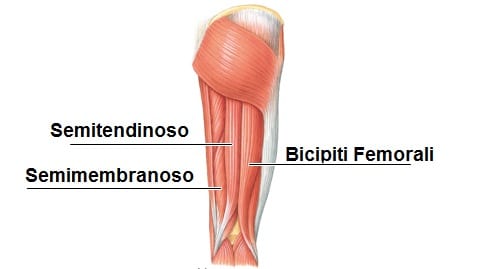By the healthiergang writer , student in Physiotherapy.
Femoral Stretching
The hamstrings are a muscle group that often tends to shorten and therefore to limit mobility in numerous exercises.
This sad fate is due, in most cases, to hours of work in front of the computer or sitting at a desk.
Femoral muscles
The term "femoral muscles" refers to the muscles that occupy the posterior portion of the thigh.
To be precise, these muscles must be identified as hamstring. The hamstrings are 3 distinct muscles of which one of these, the hamstring, is composed of two bundles.
Hamstrings can be grouped under two main sub-categories based on the area they occupy:

- Medial crural ischium: they are found in the most central part of the thigh and are the semitendinosus and the semimembranous. both of these muscles originate from the ischial tuberosity and are inserted medially on the tibia (precisely the semitendinosus takes part in the goose leg while the semimembranosum on the posterior surface of the medial condyle of the tibia). Looking at their point of origin and their point of insertion it is easy to understand how both of these muscles are involved in movements of the hip and knee joints.
- Lateral crural ischium: they are located in the more lateral part of the back of the thigh and are the two bundles of the hamstring: long head and short head. The long head originates from the ischial tuberosity while the short head originates from the harsh line of the femur. These two bundles are inserted on the head of the fibula (or fibula) and on the lateral surface of the tibial condyle. Observing the point of origin and insertion we understand how the long head is involved in the hip and knee joint while the short head only participates in movements involving the knee.
Being in the same lodge as the thigh, it can be understood that these muscles will have a common action on the joints in which they are involved, in particular:
- Coxo- femoral (hip): the muscles originating from the ischial tuberosity participate in hip extension. Furthermore, the medial hamstring intra-rotates the femur while the extra lateral hamstrings rotate this bone.
- Knee: all hamstrings participate in knee flexion
Considering the function of the hamstring, we can deduce the reason why so frequently they tend to shorten when you spend several hours sitting: these muscles in this position are perpetually shortening and can not help but suffer the consequences.
At the knee this is held in a flexion position while the pelvis is kept flexed because it is more comfortable. A flexed pelvis is meant to rotate the back forward.
Common mistakes
The problem with most of the stretching exercises that are prescribed for hamstring is that you go to work on the flexor function of the knee but not on the extension function of the pelvis.
And this is precisely the part that needs more attention.
These are the classic stretches that require you to have a sitting position on the ground with your legs in front of you and to stretch forward until you touch your feet with your hands. This position provides that you go to lean forward with the torso and therefore it is as if one were going to lengthen a part of the muscle but shortening another portion.
An Exercise To Practice
An effective stretching exercise that allows you to work on both functions of this muscle could be the following.
- While sitting on a raised shelf (a chair or a bed), bring your legs in front of you.
- At this point, extend the knee (contract the quadriceps so that the entire lower limb is aligned) and then extend the pelvis.
- For this last step it is useful to focus on your pelvis and imagine rotating the upper part forward.
- The result should consist of heels touching the ground, straight lower limb, hyper-extended lower back, and the rest of the torso tending upward.
- If these steps are done correctly you should immediately feel a strong stretch in the back of the thigh.
This exercise it's simple and can be done anywhere, in a short break while you are in front of your work computer or just waking up or before going to sleep.
The duration of the stretch should be around 30-60 seconds and attendance satisfies one's needs (in this case there is no limit, the 3 proposed moments could be fine).


























